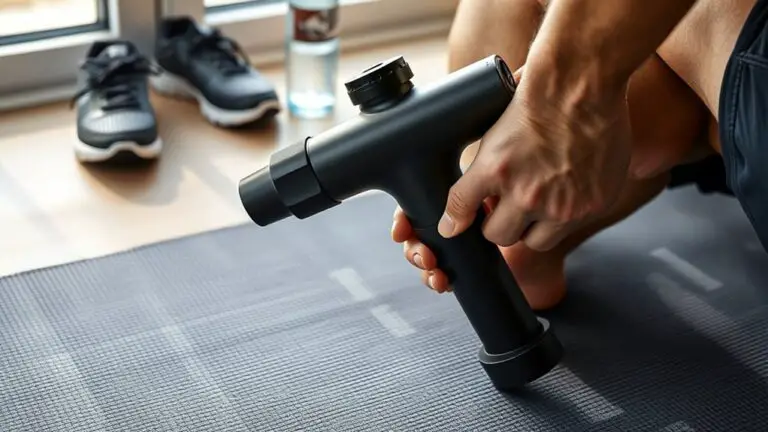The Role of Physical Therapy in Gym Training
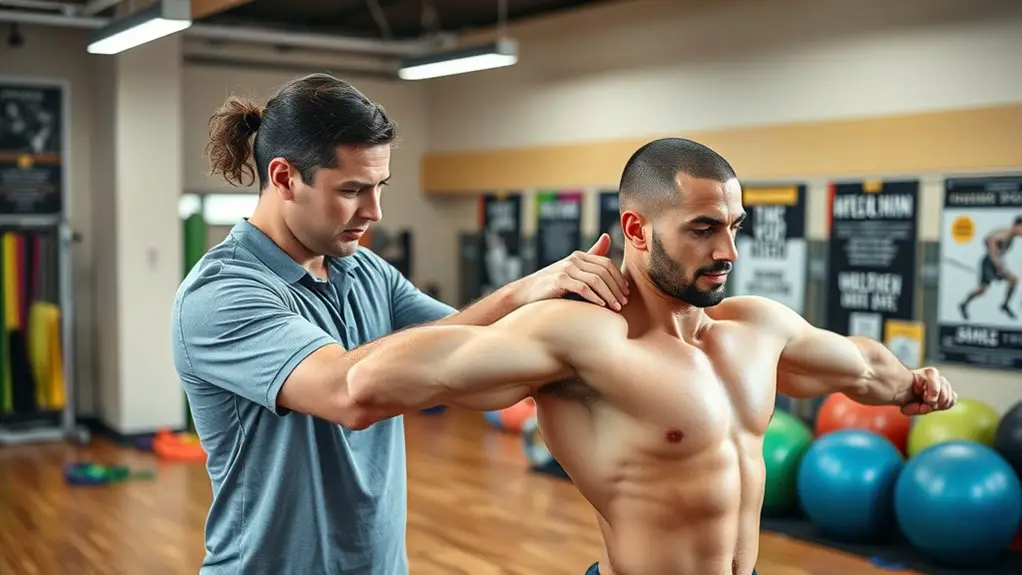
Physical therapy plays an essential role in your gym training by enhancing performance, preventing injuries, and supporting recovery. It uses customized exercise programs, biomechanical analysis, and manual therapy to help you understand your body’s mechanics. By focusing on mobility and flexibility, you’ll not only reduce your risk of injury but also improve your overall workout efficiency. Embracing physical therapy can lead to long-term fitness success, and there’s much more to explore about its benefits for your training journey.
Understanding Physical Therapy and Its Importance

When you think about physical therapy, it’s easy to overlook its critical role in gym training. Yet, understanding its importance can enhance your fitness journey considerably. Physical therapy uses various therapeutic modalities to address individual needs, promoting recovery and optimizing performance. These modalities can include exercises, manual therapy, and modalities like ultrasound or electrical stimulation, each tailored to support your specific goals.
Moreover, patient education is a cornerstone of effective physical therapy. By empowering you with knowledge about your body, proper techniques, and recovery strategies, therapists help you make informed decisions. This education not only aids in improving your current performance but also fosters long-term wellness, preventing future setbacks. Embracing physical therapy as part of your gym routine guarantees you’re not just pushing through workouts but doing so in a way that promotes health, resilience, and overall success in achieving your fitness aspirations.
Injury Prevention Through Physical Therapy
While you may focus on pushing your limits in the gym, it’s crucial to remember that injury prevention is just as important for achieving your fitness goals. By incorporating physical therapy into your routine, you can minimize the risk of injuries and enhance your overall performance. Here are three key strategies to contemplate:
- Prehab Exercises: These targeted exercises strengthen vulnerable areas, preparing your body for the demands of your workouts.
- Biomechanics Analysis: Understanding your body mechanics can help identify movement patterns that may lead to injury, allowing for timely adjustments.
- Regular Assessments: Frequent evaluations by a physical therapist can catch potential issues before they become serious, ensuring your training remains safe and effective.
Prioritizing injury prevention through these approaches can enhance your gym experience, allowing you to train harder and longer without setbacks.
Enhancing Performance With Therapeutic Techniques
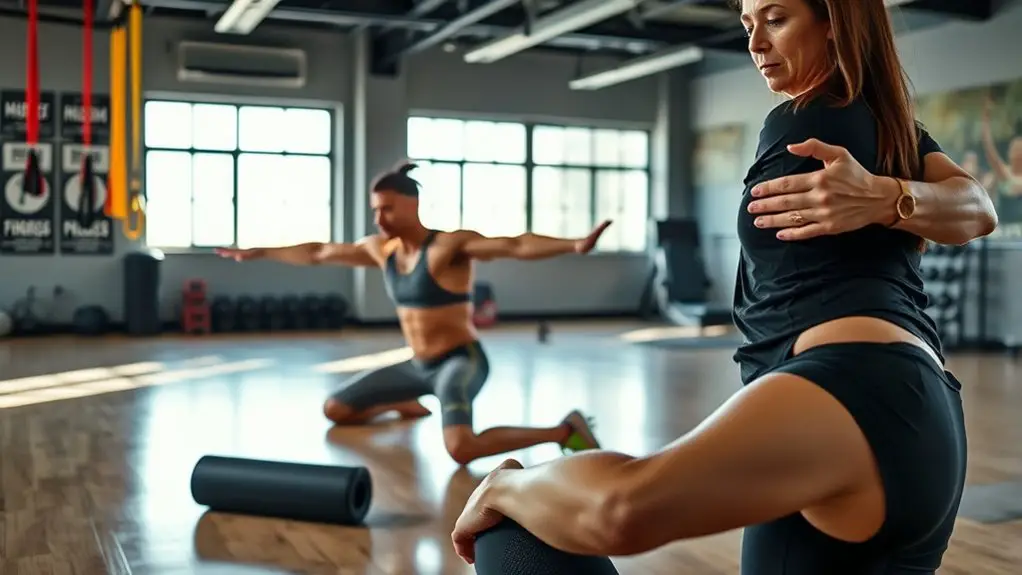
To enhance your performance in the gym, it is crucial to incorporate therapeutic techniques that address your unique needs. By focusing on injury prevention strategies, customized exercise programs, and effective recovery techniques, you can maximize your potential while minimizing the risk of setbacks. Understanding these elements will empower you to train smarter and achieve your fitness goals.
Injury Prevention Strategies
Incorporating effective injury prevention strategies into your gym training can greatly enhance your performance and overall well-being. By focusing on prehabilitation exercises and improving your body mechanics, you can markedly reduce your risk of injury. Here are three strategies to contemplate:
- Regular Assessments: Schedule assessments with a physical therapist to identify any weaknesses or imbalances in your body mechanics.
- Prehabilitation Exercises: Integrate targeted prehabilitation exercises into your routine to strengthen vulnerable areas and improve stability.
- Proper Technique: Always prioritize proper form during workouts to guarantee the right body mechanics and minimize strain.
Customized Exercise Programs
Building on the foundation of injury prevention, customized exercise programs are pivotal in enhancing your performance through therapeutic techniques. By integrating personalized training and adaptive workouts into your routine, you can target specific areas of improvement while ensuring safety and effectiveness. These tailored programs consider your unique fitness level, goals, and any pre-existing conditions.
| Component | Benefits |
|---|---|
| Personalized Assessment | Identifies strengths and weaknesses |
| Goal Setting | Creates a clear path to success |
| Adaptive Workouts | Adjusts to your progress |
| Technique Refinement | Enhances form and efficiency |
| Ongoing Support | Provides motivation and accountability |
With these elements, you’ll experience a significant boost in performance and overall well-being.
Recovery and Rehabilitation Techniques
While pushing your limits in the gym can yield impressive results, understanding recovery and rehabilitation techniques is essential for sustaining performance and preventing injuries. Incorporating effective recovery methods can enhance your overall training experience. Consider these techniques:
- Manual Therapy: This hands-on approach helps relieve muscle tension and improve mobility, allowing you to recover faster and perform better.
- Therapeutic Modalities: Techniques like ultrasound or electrical stimulation can reduce inflammation and promote healing, ensuring you’re back at it sooner.
- Active Recovery: Engaging in low-intensity activities on rest days can stimulate blood flow, aiding in muscle repair and reducing soreness.
The Role of Mobility and Flexibility in Gym Training
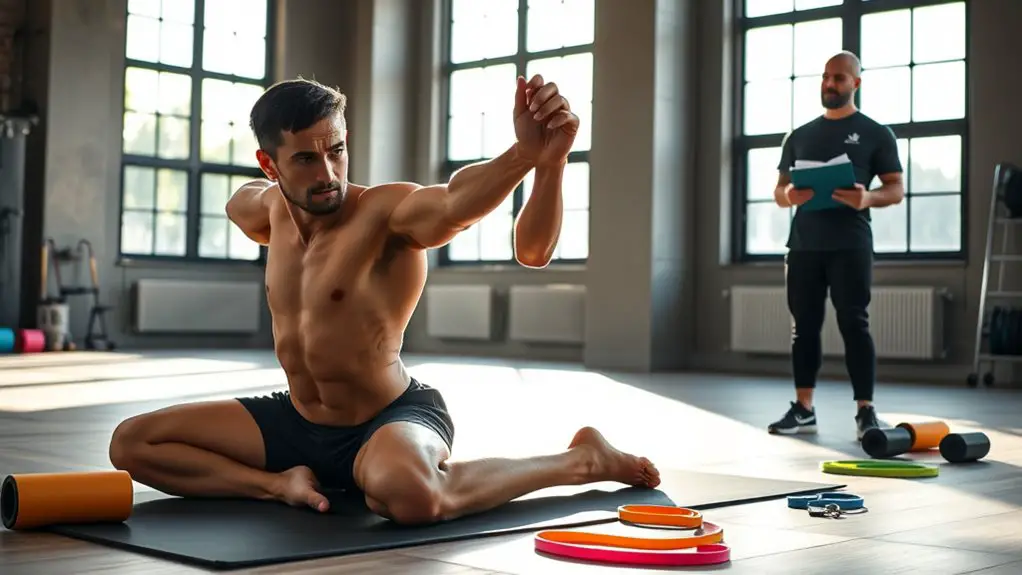
Mobility and flexibility play essential roles in gym training, as they directly impact your overall performance and injury prevention. Incorporating dynamic stretching into your warm-up routine enhances your range mobility, allowing your muscles and joints to move more freely. This increased mobility not only improves your athletic performance but also reduces the risk of strains and tears during workouts.
When you prioritize flexibility, you’re not just increasing your ability to perform exercises; you’re also promoting better posture and alignment. This can lead to more effective workouts and less discomfort over time. Remember, tight muscles can limit your range of motion, leading to compensation patterns that might cause injuries.
Customized Rehabilitation Programs for Gym Enthusiasts
When it comes to achieving your fitness goals, customized rehabilitation programs can play a pivotal role, especially for gym enthusiasts recovering from injuries or managing chronic conditions. By focusing on your unique needs, these programs utilize various rehabilitation techniques to enhance recovery and performance.
Here are three key components of a successful customized rehabilitation program:
- Personalized Assessments: Your journey starts with a thorough evaluation to identify specific issues and set realistic goals.
- Tailored Exercise Plans: Based on your assessment, you’ll receive a plan designed to strengthen vulnerable areas while promoting overall fitness.
- Ongoing Support and Adjustments: Regular check-ins guarantee your program adapts to your progress, making necessary adjustments to keep you on track.
Investing in a personalized rehabilitation program not only aids recovery but also empowers you to return to the gym stronger and more resilient than before.
The Connection Between Physical Therapy and Recovery
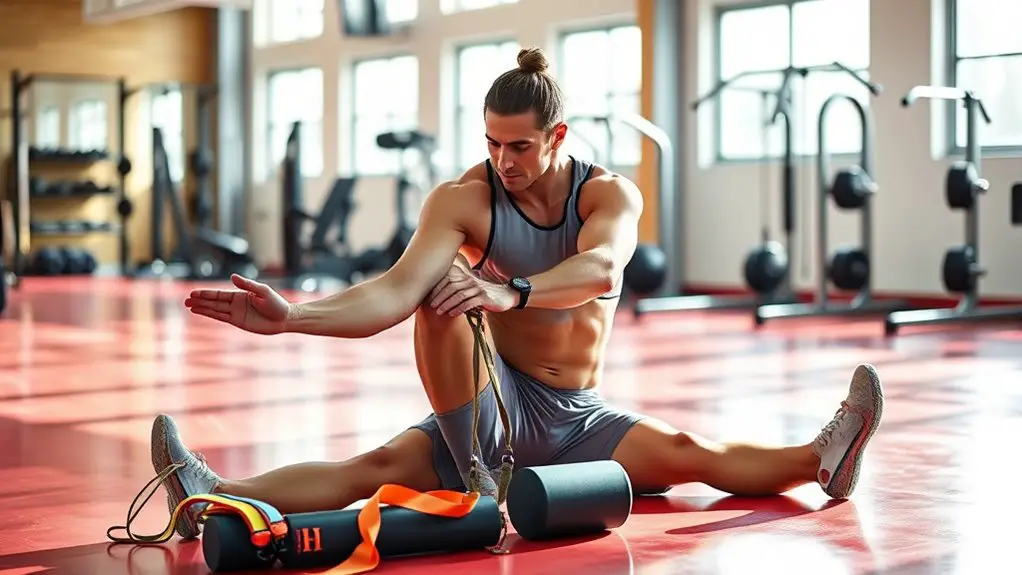
Understanding the connection between physical therapy and recovery is essential for any gym enthusiast. You’ll find that effective injury prevention strategies and tailored rehabilitation techniques not only help you heal but also enhance your overall performance. By focusing on these elements, you can guarantee a more resilient and efficient path to achieving your fitness goals.
Injury Prevention Strategies
While engaging in gym training can markedly enhance your physical fitness, it’s crucial to recognize that injury prevention is equally important for long-term success. Incorporating effective strategies can help you stay on track. Here are three key approaches:
- Dynamic Warm Ups: Start each session with dynamic movements to enhance blood flow and prepare your muscles for exertion.
- Strength Assessments: Regularly assess your strength levels to verify you’re not overexerting yourself and to identify areas needing improvement.
- Proper Technique: Focus on maintaining proper form during exercises to minimize the risk of injury and maximize effectiveness.
Rehabilitation Techniques Explained
Injury prevention strategies lay a solid foundation, but when injuries do occur, effective rehabilitation techniques become vital for recovery. You’ll find that various rehabilitation modalities, such as manual therapy and modalities like ultrasound or electrical stimulation, can considerably aid your healing process. These techniques help reduce pain and inflammation, allowing you to regain mobility. Coupled with therapeutic exercises tailored to your specific injury, they play an essential role in rebuilding strength and flexibility. Your physical therapist will guide you through a progressive regimen designed to restore function while minimizing the risk of re-injury. By adhering to a structured rehabilitation plan, you can guarantee a smoother shift back to your regular gym training, ultimately enhancing your overall fitness journey.
Enhanced Performance Recovery
When it comes to enhancing performance recovery, the role of physical therapy cannot be overstated. Effective recovery strategies can greatly reduce muscle soreness and improve your overall gym performance. Here are three ways physical therapy aids in recovery:
- Active Recovery Techniques: Engaging in low-intensity exercises helps facilitate blood flow, reducing muscle soreness and expediting recovery.
- Manual Therapy: Techniques like massage and myofascial release can target tight areas, alleviating discomfort and enhancing mobility.
- Personalized Stretching Protocols: Tailored stretches can enhance flexibility, prevent injuries, and promote quicker recovery.
Common Gym Injuries and How Physical Therapy Helps

Although gym training offers numerous benefits, it also comes with the risk of common injuries that can hinder your progress and overall well-being. Injuries like knee injuries, shoulder strains, back pain, and ankle sprains are prevalent among gym-goers. Physical therapy plays an essential role in your recovery process, helping you regain strength and mobility while preventing future injuries.
| Common Injury | How Physical Therapy Helps |
|---|---|
| Knee Injuries | Strengthening exercises and stretching |
| Shoulder Strains | Manual therapy and posture correction |
| Back Pain | Core stabilization and pain management |
| Ankle Sprains | Balance training and functional exercises |
| General Recovery | Personalized rehabilitation programs |
Integrating Physical Therapy Into Your Workout Routine
Integrating physical therapy into your workout routine can greatly enhance your performance and reduce the likelihood of injuries. By incorporating therapeutic modalities and focusing on progress tracking, you’ll create a more effective and safer training environment. Here are three ways to seamlessly blend physical therapy into your regimen:
- Assessment and Goal Setting: Begin with a thorough evaluation by a physical therapist. This helps establish a baseline and set realistic goals tailored to your needs.
- Incorporating Exercises: Use targeted exercises recommended by your therapist. These will not only strengthen specific muscle groups but also improve flexibility and stability.
- Regular Check-Ins: Schedule periodic sessions with your physical therapist to assess your progress. This guarantees you’re on track and allows for adjustments in your program as needed.
Long-Term Benefits of Combining Physical Therapy With Gym Training
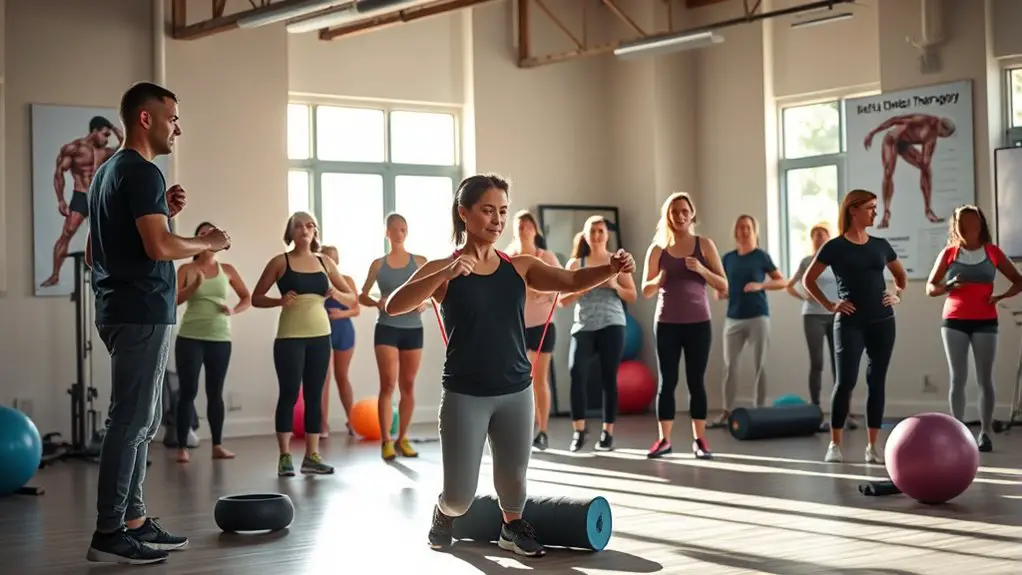
Combining physical therapy with gym training offers numerous long-term benefits that extend beyond immediate performance gains. By integrating these two disciplines, you can enhance your injury awareness, ensuring you avoid pitfalls that may hinder your progress. This combination not only promotes optimal physical function but also fosters sustainable, long-term gains in strength and flexibility.
| Long-Term Benefits | Description |
|---|---|
| Injury Prevention | Enhances awareness of body mechanics, reducing injury risks. |
| Improved Recovery | Accelerates healing through tailored rehabilitation exercises. |
| Enhanced Performance | Builds strength and flexibility for better gym results. |
| Increased Longevity | Promotes sustainable fitness, allowing you to train effectively over time. |
Ultimately, by embracing both physical therapy and gym training, you’re investing in your long-term health and athletic performance, creating a solid foundation for continued improvement.
Frequently Asked Questions
How Often Should I See a Physical Therapist While Training?
How often you should see a physical therapist while training really depends on your individual needs and goals. Frequency recommendations typically suggest bi-weekly or monthly visits for consistent progress evaluation, especially if you’re recovering from an injury. Regular check-ins can help you stay on track and adjust your training as needed. Ultimately, it’s important to communicate with your therapist to determine the best schedule for your situation and guarantee ideal recovery and performance.
Can Physical Therapy Help With Specific Sports Injuries?
Yes, physical therapy can definitely help with specific sports injuries. By utilizing tailored rehabilitation techniques, you can effectively address your injury, enhance recovery, and regain strength. Additionally, a physical therapist can provide valuable insights into injury prevention strategies, ensuring you’re less likely to encounter similar issues in the future. Their expertise not only aids in healing but also empowers you to perform at your best while minimizing the risk of re-injury.
What Qualifications Should I Look for in a Physical Therapist?
When looking for a physical therapist, consider their experience levels and certification types. A licensed therapist should have a Doctor of Physical Therapy (DPT) degree and be board-certified in their specialty, if applicable. It’s essential to assess their experience with your specific injury or condition, as this can greatly affect your recovery. Additionally, check for any continuing education courses they’ve taken to stay updated on the latest techniques and treatments.
How Do I Know if I Need Physical Therapy for My Gym Routine?
Did you know that nearly 50% of gym-goers experience some sort of injury each year? If you’re facing persistent pain, decreased performance, or limitations in your movements, those could be key indicators for therapy. A thorough training assessment can help identify any underlying issues that might be affecting your routine. Listening to your body is essential; if something feels off, it’s wise to consult a physical therapist to prevent further complications.
What Are the Costs Associated With Physical Therapy Sessions?
The costs associated with physical therapy sessions can vary considerably based on factors like session duration and insurance coverage. Typically, sessions last about 45 minutes to an hour, and without insurance, prices can range from $75 to $200 per session. If you’ve got insurance, check your plan; some may cover a portion of the costs. It’s crucial to understand your financial responsibilities to make informed decisions about your therapy needs.

